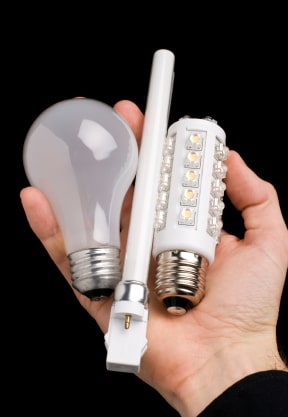How to Upgrade Your Home’s Incandescent Light Bulbs Using Lumens
 Upgrading your home’s lighting by replacing old, inefficient incandescent light bulbs with new, energy-efficient compact fluorescent lamps (CFLs) or light-emitting diodes (LEDs) can help you reduce monthly electric bills. However, shopping for CFLs and LEDs might be a little confusing at first because youre probably used to shopping for light bulbs based on watts, or the amount of power light bulbs use. Since CFLs and LEDs use fewer watts than incandescent bulbs to produce the same amount of light, you’ll instead need to shop for replacement bulbs based on brightness, or lumens.
Upgrading your home’s lighting by replacing old, inefficient incandescent light bulbs with new, energy-efficient compact fluorescent lamps (CFLs) or light-emitting diodes (LEDs) can help you reduce monthly electric bills. However, shopping for CFLs and LEDs might be a little confusing at first because youre probably used to shopping for light bulbs based on watts, or the amount of power light bulbs use. Since CFLs and LEDs use fewer watts than incandescent bulbs to produce the same amount of light, you’ll instead need to shop for replacement bulbs based on brightness, or lumens.
Lumens are a measure of visible light emitted by a light bulb, while watts measure the amount of electricity it takes to produce those lumens. A 100-watt incandescent light bulb might produce 1,600 lumens, but a common CFL that produces 1,600 lumens might only use 25 watts and a common LED might use only 18 watts. After all, being able to use fewer watts to produce the same amount of light is what makes CFL and LED bulbs so energy is efficient.
To help you find the right type of replacement CFLs or LEDs for your incandescent bulbs, heres a handy chart to help you match lumens when you shop so that you get the brightness youre looking for out of your new, energy-efficient light bulbs.
| Incandescent Bulbs (watts) |
Minimum Brightness (lumens) |
Common CFL Bulbs (watts) |
Common LED Bulbs (watts) |
|---|---|---|---|
|
25 |
250 |
4’9 |
4’5 |
|
40 |
450 |
9’13 |
6’7 |
|
60 |
800 |
13’15 |
7’8 |
|
75 |
1,100 |
18’25 |
9’13 |
|
100 |
1,600 |
23’30 |
16’20 |
|
125 |
2,000 |
22’40 |
20’25 |
|
150 |
2,600 |
40’45 |
25’28 |
Sources
Eartheasy, LED Light Bulbs: Comparison Charts.
ENERGY STAR, Learn About Light Output.



